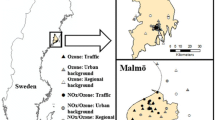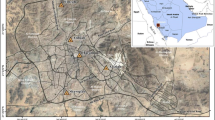Abstract
Ground-level tropospheric ozone is one of the air pollutants of most concern. Ozone levels become particularly high in regions close to high ozone precursor emissions and during summer, when high insolation and high temperatures are common. Ozone levels continue to exceed both target values and the long-term objectives established in EU legislation to protect human health and prevent damage to ecosystems, agricultural crops and materials. Researchers or decision-makers frequently need information about atmospheric pollution patterns in urbanized areas. The preparation of this type of information is a complex task, due to the influence of several factors and their variability over time. In this work, some results of urban ozone distribution patterns in the city of Badajoz, which is the largest (140,000 inhabitants) and most industrialized city in Extremadura region (southwest Spain) are shown. Twelve sampling campaigns, one per month, were carried out to measure ambient air ozone concentrations, during periods that were selected according to favourable conditions to ozone production, using an automatic portable analyzer. Later, to evaluate the overall ozone level at each sampling location during the time interval considered, the measured ozone data were analysed using a new methodology based on the formulation of the Rasch model. As a result, a classification of all locations according to the ozone level, which was the value of the Rasch measure, was obtained. Moreover, information about unexpected behaviours of ozone patterns was generated. Finally, overall ozone level at locations where no measurements were available was estimated which can be used to generate hazard assessment maps.







Similar content being viewed by others
References
Adame JA, Lozano A, Bolívar JP, De la Morena BA, Conteras BA, Godoy F (2008) Behavior, distribution and variability of surface ozone at an arid region in the south of Iberian Peninsula (Sevilla, Spain). Chemosphere 70:841–849
Álvarez P (2004) Transforming non categorical data for Rasch analysis. Rasch measurement in health sciences. Jam press, Maple Grove, MN
Bode RK, Wright BD (1999) Rasch measurement in higher education. In: Smart JC, Tierney WG (eds) Higher education: handbook of theory and research, vol 14. Agathon Press, New York, pp 287–316
Bond TG, Fox CM (2007) Applying the Rasch Model: fundamental measurement in the human sciences, 2nd edn. Lawrence Erlbaum Associates, Mahwah, NJ
Edwards A, Alcock L (2010) Using Rasch analysis to identify uncharacteristic responses to undergraduate assessments. Teach Math Appl 29:165–175
EEA (2007) Air pollution in Europe 1990–2004. European Environmental Agency Report No 2/2007. http://www.eea.europa.eu
EEA (2013) Europe’s air today. European environmental agency article. http://www.eea.europa.eu/signals/signals-2013/articles/europes-air-today
Fassò A (2013) Statistical assessment of air quality interventions. Stoch Environ Res Risk Assess. doi:10.1007/s00477-013-0702-5
Fernánez-Fernández MI, Gallego MC, García JA, Acero FJ (2011) A study of surface ozone variability over the Iberian Peninsula during the last 50 years. Atmos Environ 45:1946–1959
Gimeno L, Hernández E, Rúa A, García R, Martín I (1999) Surface ozone in Spain. Chemosphere 38:3061–3074
Kaya I, Kahraman C (2009) Fuzzy robust process capability indices for risk assessment of air pollution. Stoch Environ Res Risk Assess 23:529–541
Kumar U, Jain VK (2010) ARIMA forecasting of ambient air pollutants (O3, NO, NO2 and CO). Stoch Environ Res Risk Assess 24:751–760
Lefohn AS (1992) Surface ozone exposures and their effects on vegetation. Lewis publishers, Chelsea
Linacre JM (2009) WINSTEPS (Version 3.69) [computer program]. Chicago
Martín P, Cabañas B, Villanueva F, Gallego MP, Colmenar I, Salgado S (2010) Ozone and nitrogen dioxide levels monitored in an urban area (Ciudad Real) in central-southern Spain. Water Air Soil Pollut 208:305–316
Moral FJ, Álvarez P, Canito JL (2006) Mapping and hazard assessment of atmospheric pollution in a medium sized urban area using the Rasch model and geostatistics techniques. Atmos Environ 40:1408–1418
Moral FJ, Valiente P, López F (2010) Geostatistical analysis and mapping of ground-level ozone in a medium sized urban area. Int J Environ Sci Eng 2:71–82
Moral FJ, Terrón JM, Rebollo FJ (2011) Site-specific management zones based on the Rasch model and geostatistical techniques. Comp Electron Agric 75:223–230
Rasch G (1980) Probabilistic models for some intelligence and attainment tests (revised and expanded ed.). University of Chicago Press, Chicago
Ribas A, Peñuelas J (2004) Temporal patterns of surface levels in different habitats of the north western Mediterranean basin. Atmos Environ 38:985–992
Sekaran U (2000) Research methods for business: a skill building approach. Wiley, Singapore
Smith RM (1996) Polytomous mean-square statistics. Rasch Meas Trans 6:516–517
Tristán A (2002) Análisis de Rasch para todos. Editorial Ceneval, Mexico
Vingarzan R (2004) A review of surface ozone background levels and trends. Atmos Environ 38:3431–3442
Acknowledgments
The authors thank to Junta de Extremadura (Research Group TIC008, co-financed by European FEDER funds), for partially financing this work.
Author information
Authors and Affiliations
Corresponding author
Rights and permissions
About this article
Cite this article
Moral, F.J., Rebollo, F.J. & Méndez, F. Using an objective model to estimate overall ozone levels at different urban locations. Stoch Environ Res Risk Assess 28, 455–465 (2014). https://doi.org/10.1007/s00477-013-0764-4
Published:
Issue Date:
DOI: https://doi.org/10.1007/s00477-013-0764-4




